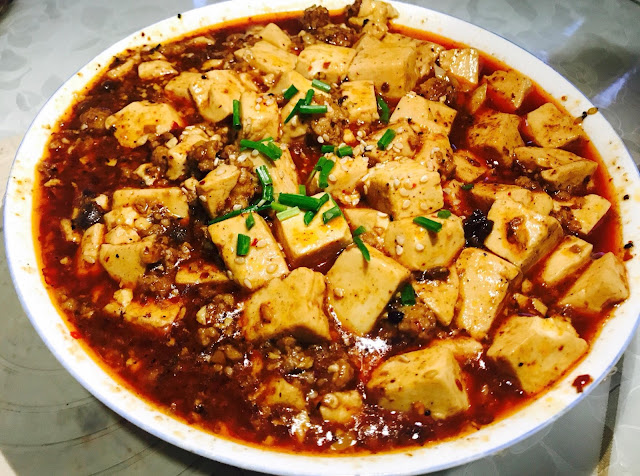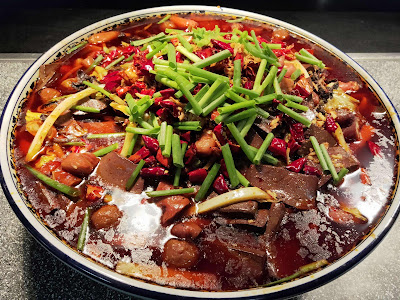Sichuan Food
Mapo Tofu
The tofu made by old lady Chen, customarily called Mapo tofu, was created in 1862. The dish got its name from Lady Chen who wore freckles on her face.
People who came to Lady Chen's restaurant were mainly oil workmen. They often bought some tofu and beef and offered Lady Chen some vegetable oil on their own, asking her to cook for them. With time passing by, Lady Chen acquired a special way of cooking tofu with the great color, aroma and taste and people enjoyed it very much. It was not long before the tofu gained fame.
Some nosy workmen began to call it Mapo Tofu when they observed the freckles on Chen's face. It was soon spread and became a story padded on with approval. The restaurant changed its name accordingly to Mapo Tofu. With the constant efforts by the heirs one generation after another, Mapo Tofu passed on and on over one hundred and forty years, remaining popular among the gourmet at home and even abroad.
The Fish Hotpot
Located in the streamside of the Yangtze River and the Jialing River, Chongqing serves as an important water transportation junction in Southwest China. Through a long period of personnel and cargo exchange, people in Chongqing have formed an open and tolerant character. This character has promoted fish pot almost to its perfection.
In the middle of 1980s, merchants gathered around Chongqing Jiangbei International Airport (CKG) and gradually formed "a street of fish pot". To cater to the flavor of people who came from all parts of China, the owners of fish pot restaurant kept adopting new materials and stuffs, thus creating the systematic fish pot species. The fish comes from both freshwater and the deep ocean. The flavor includes mildly spicy, spicy, strong spicy. And there is a differentiation between pepper and soup as well. A fish pot with so many varieties is surly welcomed by customers all over the world.
Thousands of fish pot restaurant, small or big, are witnessing the legend of fish one after another.
Spicy Pot
Spicy pot, a branch of Sichuan cuisine, gains popularity in recent years with the hot, spicy, dry and delicious taste.
It's said that the locals prefer to fry a big pot of vegetables together with some sauces in Sichuan. When the house is visited by someone important, people will add some meat and seafood into the pot which usually contains various kinds of vegetables. The meat is tender, the bamboo shoots crispy and the vegetables are delicious when mixed in one big pot.
In terms of choosing the pepper in spicy pot, there are many rules and standards. The "Erjingtiao" pepper in the west of Sichuan turns out to be the best. Though red and hot, it doesn't hurt the stomach or raise the internal heat. Once cooked in the pot, the pepper looks bright and fills the room with strong scent. Nowadays, the spicy pot is cooked in a single pot which meets the healthy standard in modern time. No wander it is so irresistible for all people who love spicy food.
Pork Lungs in Chili
Once there was a Hui ethnic community near Chengdu, Sichuan province. They ate beef and mutton mostly. However, they seldom touched the entrails which were discarded directly on the edge of the slaughter house.
A young couple, surnamed Guo, who was worrying about their future life thought it wasteful abandoning these ox tripe and tongues. So they came to the slaughter house very early in the morning and picked some entrails which could be eaten. They carefully washed and boiled them to the right point of time control.After their elaborate processing, the ox tripe was as white as writing paper and the ox tongue was as reddish as the birch bark. By adding other sauces such as red oil, pepper, sesame, sesame oil, Monosidum glutamate (MSG), soy and fresh celery, the entrails in sauce was attractive both in its bright appearance and spicy taste.
Because the chopped ox entrails in sauce made by the Couple was cheap and delicious, people who were too poor to buy some meat came to this place frequently. Since then, more and more people are getting familiar with it.
Hot and Sour Sweet Potato Noodles
Regarding to the origin of hot and sour sweet potato noodles, an allusion wildly spread among populace.
Dated back to the Three Kingdoms period, when Liu Bei, Guan Yu and Zhang Fei swore to brotherhood in a peach orchard, the owner of the orchard prepared a meal for them. The major ingredient of the meal was sweet potato noodles which were favored by lots of people at that time. The long noodle was a symbol of their long-lasting friendship. As for the condiments, Liu bei suggested that small hot pepper, pickles, brown sugar and coptis be put into the soup, whose implied meaning was that they share happiness and woe, fearless when confronted by any sweets and bitters of life.
This is the story of hot and sour sweet potato noodles. And it runs a long history till now with bursting vitality facing the future.
Long Wonton
Long Wonton, as suggested in the dish name, is an elegant dish named after its shape. In ancient times, the emperor always proclaimed themselves as the Son of Heaven, representing the dragon. There was also a story about an emperor behind the Long wonton.
It's said that the Emperor Xizong was playful and had a special interest in food and he kept thinking about the delicious court dessert even when he fled his way to Chengdu. But despite their superb cooking skill, the local chefs in Chengdu had no idea about how to make the court dessert appealing in North China. This was really a difficult task for the local chef. When discussing what kind of dessert may please the Emperor, one chef found that the Emperor was viewing the beautiful sight beyond the temple with his hands crossing in front of his chest. This elegant gesture impressed the chef and an idea occurred in his mind. He proposed to imitate the gesture of the Emperor and fold the wrapper with meat stuffing, with its two angle pointing forward. All agreed upon the idea.
So was the pie with a special shape. How could the Dragon live without water? The chef wondered. Then he made some Sichuan style soup to server with dragon wonton.
Learning of its origin, the Emperor Xizong was very pleased and ate all the dragon wontons. A royal dish name was thus given as Long wonton.
Spicy Chicken
Hundreds of delicious foods fight for their position at all corners of the country with their distinct enchantment. Spicy chicken is widely acknowledged for the first or second place. The chicken in Geleshan stands out as the most prestigious and influential one among local multitudinous restaurants selling Spicy Chicken.
The founder Zhu Tiancai fired the small slice of chicken with large amount of red pepper. It's hot and spicy with bright color and pungent smell, thus gaining fame in high streets and back lanes. People attracted by its reputation lined up to an unprecedented degree. Seeing the business opportunities in it, the neighboring farmers began to imitate and gradually there formed a street that sold spicy chicken, similar to the Gui Street in Beijing where various hot and spicy Sichuan food were provided in agglomeration.
As a matter of fact, spicy chicken is no longer a pure dish name. It represents the local culture of Chongqing-slow and leisure. People talk about their impression upon this city and are longing for this kind of pleasant lifestyle when they are enjoying the tasty food there. This dish injects a current of food culture and contributes to the development of Chongqing in a unique way, by which spicy chicken fulfills its value at a higher level.
If you want to make a "mild version" of spicy chicken, it's unnecessary to apply too much sauce. The raw materials contain chicken leg, cooking wine, salt, shallots, ginger, garlic, pepper, dry red peppers, sesame and sugar. First of all, you cut the chicken leg into small pieces and salt it with cooking wine and last for half an hour until they are fully integrated into the meat. Then you heat the oil and fry the chicken till its surface becomes golden dry. When you fried the shallots, garlic on big fire and put the peppers into the pot, you fry them for a minute till you smell the pungent spicy pepper. It's time to pour the chicken in and add some sugar as you prefer. After stir-frying for a few minutes, you scatter the sesame into it and pull them on a plate. The healthy spicy chicken with endless aftertaste can be served on the table now!
Duck Blood Cake
We are all delighted to order Duck Blood Cake whenever we are having Sichuan cuisine. This seems to be a standard behavior of our dining-out in Chuan Food Restaurant. But what kind of blood is it in the spicy soup? Pig blood? Duck blood? Why is it connected with "Mao"? It was said that in the 1920s, Duck Blood Cake first appeared in Ciqikou town in Chongqing and was made by a man whose surname was "Mao". He was expecting a prosperous business when he started the shop. So he hopefully named this dish "Mao" Duck Blood Cake.
Moreover, there is another story among folks. A butcher whose surname was Wang lived in Ciqikou and sold the chopped entrails at a very low price every day. His wife felt that these entrails were sold too cheap. Therefore, she opened a stall to sell entrails soup made of pork head meat, pork bone and peas. She also added pig's intestines and lungs, sliced ginger and pepper and cooking wine into the soup and boiled them with slow fire. She sold it in small bowls. One day, she added some fresh pig blood into the soup and found the soup taste even more delicious. At the same time, the pig blood was tender enough. This was well welcomed by the diners. Thereafter, people began to sell fresh pig blood in the market.
Well, what we should choose to make Prosperous Blood in Spicy Soup of Mao's, pig blood or duck blood? In fact, this doesn't matter. At the very beginning, it is made of pig blood. But now duck blood is accepted as well as long as the blood is tender and pliable. So far, the ingredients to accompany Prosperous Blood in Spicy Soup of Mao's become more diverse, like bean sprout, oyster mushroom, potato, agaric, spiced ham, intestines. Everything you are expecting can be found in it.



















No comments